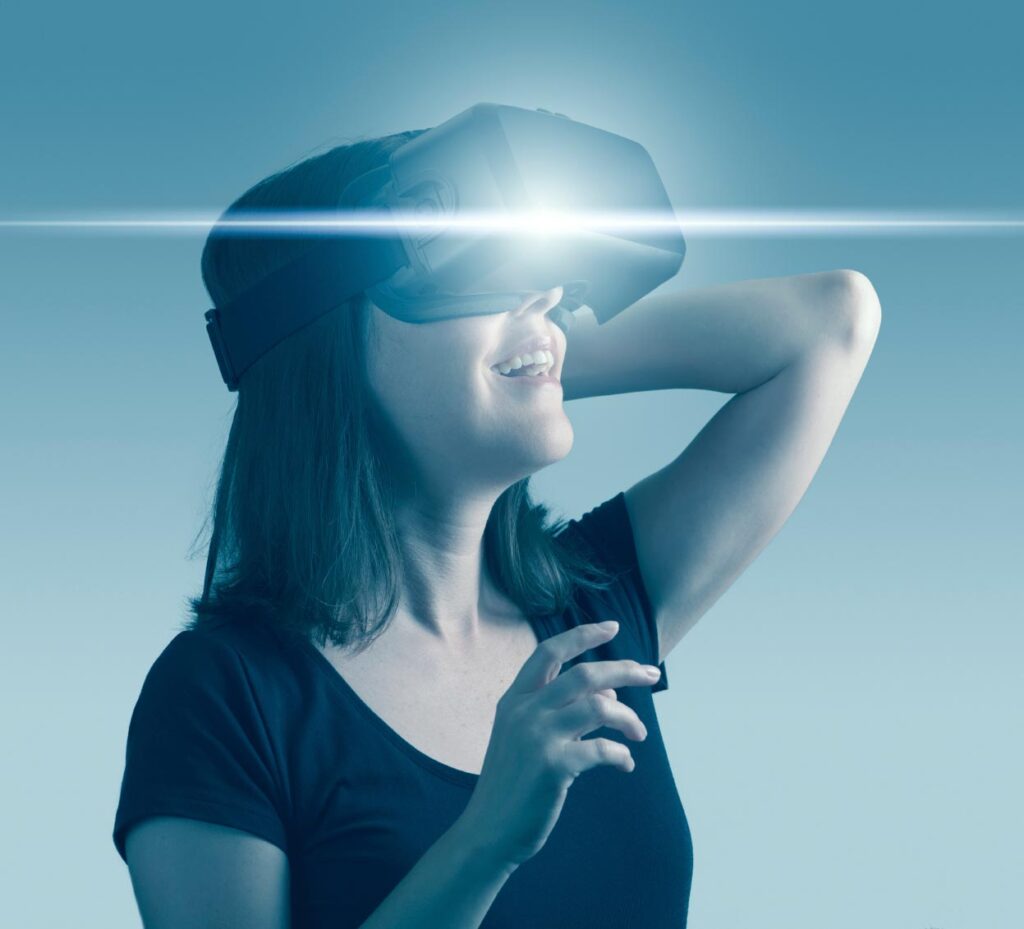Welcome to Content Minus, an offbeat look at the trends and topics traversing the world of marketing. This month: virtual reality!
The Ford Model T. The Polaroid camera. The iPhone. Olive Garden. Like the many disruptive technologies that have come before it, virtual reality—or VR, the reality replacing technology made popular by terrible films from the 90’s—stands poised to revolutionize the experience industry. With technology providers like Occulus, HTC, and Samsung rushing to release a horde of affordable VR headsets and an ever increasing number of brands beginning to create and adapt content for this new platform, virtual reality may soon become the inexpensive alternative to many experiences and events once thought of as out of reach.
How exciting is that! Super exciting! Soon that stadium rock show that sold out in five minutes will offer the option to stream the show as you dance in your man cave. Or what about that vacation you could never possibly afford to that place only your polyglot wife can pronounce? Soon you’ll be able to roam the streets for mere pennies on the Krona as you both recline in your matching wingback barcaloungers.
But a question lingers; will these virtual experiences pass muster? Can they live up to the real thing? Or, is it possible… can they be better than the real thing? Let’s take a look at a couple of real life virtual offerings and see how they stack up.
Tommy Hilfiger Fashion Week
Technology and fashion. It’s a classic pairing. Whether you’re talking about wearables or augmented reality changing rooms there’s no denying these two great tastes taste great together. In October of 2015 Tommy Hilfiger, that self-described paragon of American preppy-ness, began offering their in-store patrons the option to slip on a VR headset and be whisked away to New York Fashion week. Inside the experience you’ll watch Hilfiger’s runway show, rub virtual elbows with New York’s fashion elite, and as a special treat sneak backstage and see behind the curtain.
Wow, sneak backstage. Even if you were able to make it to fashion week, that’s a level of access that borders on the Anna Wintour. It seems like a perfect experience. Almost. This is fashion week darling. The whole point of fashion week is not go and see but to go and be seen. If you’re not raising eyebrows, why bother. That being said, this experience is perfectly posh for the casual observer who can enjoy fashion week without making a fashion faux pas, thus elevating this experience to invaluable. Also, fashionistas wouldn’t be caught dead wearing a VR headset (unless it was designed by Louis Vuitton and came with matching set of Pigalle Follies pumps).
NBA Games
Whether it’s the NFL’s use of chroma key technology to digitally enhance the field or the NHL’s awesomely terrible glow puck, sports broadcasting has always been on the cutting edge. This year a handful of teams have begun offering virtual reality feeds of their games to patrons with the necessary gear. These VR broadcasts are so far pretty basic. Unlike traditional sports programming that overlays the score and stats, this experience is just like being at the game. If you want to check the score you’ll need to look up at the scoreboard. If you want to follow the action down the court you’ll need to turn your head.
In this case it feels like the benefits are outweighed by what you’re missing out on. Sure, you’re getting the best seats in the house, and no, you don’t have to walk a quarter mile to find a bathroom. But what’s the point of being courtside if you can’t tell those overpaid punks on the other team that they’re a bunch of no-talent bums. Plus, if your boys can’t hear you yell D-FENCE at the top of your lungs what’s the point? If you were there in real life wearing your lucky jersey they wouldn’t be down by 10 at the half.
Verdict: Lacking value; though they’re giving you the best seats in the house NBA franchises are offering an isolating remediation of a communal experience. More thought is needed as to how to make this sports viewing VR experience unique and enticing.

Apple’s U2 Music Video
Apple, like the cool kid who was too busy doing cool kid stuff, showed up fashionably late to the VR party. Apple’s offering is a VR music video featuring their favorite band U2 (and friends). The video, available to fans on VRSE with the appropriate hardware or access to the roaming promotional bus (at a European venue near you), brings you to an intimate backstage performance of the band’s latest offering “Song for Someone.” The virtual experience transitions between the band, collaborators, and fans—who were filmed in a number of low key locations, doubling down on the feeling you’re a part of something personal, like a home movie brought to real life.
When I first heard about this, I wanted to say something like, “Apple’s at it again, literally shoving U2 in our face.” Especially after 2014’s iTunes debacle when the company “gifted” us with the band’s album Songs of Innocence (whether you wanted it or not). But oddly, I really like this. We’ve all seen the band on stage, larger than life, doing their stadium rock thing. This is something new, something small. To be this intimate with the band in real life would require either a) spending a lot of money and influence to wrangle the band for a private show or b) being drinking buddies with the band. As much fun as that sounds like, I don’t think my liver could handle it. I’ll take the VR.
Verdict: A beautifully crafted experience that uses the technology well and helps to salve earlier marketing missteps. However, what is the greater strategy? Apple has yet to make any official announcement about their future in VR.

Should You Step into the Virtual World?
The future is here and it brought us this shiny new toy. Should we use it? Should we wait? With Oculus Rift just about to launch, and a host of other platforms nipping at its heels the time does feel right to consider a VR strategy. Whether you should or shouldn’t engage in VR depends on a number of factors. As we saw with the NBA’s execution they offered an experience already accessible to most, but missing some of the key interactive components that make the experience enjoyable.
The key to making a worthwhile VR experience is intimacy and novelty. Can you bring the audience closer, take them behind the curtain, and give them unprecedented access (eg: The Displaced from the New York Times Magazine and VRSE)? Can you show them something unique, other-wordly, the otherwise impossible (eg: Warcraft: Skies of Azeroth from Legendary Entertainment)? The best experiences take advantage of the technology, draw the user in, make them feel apart of the experience, and ultimately forge a lasting bond.



